This was our first visit to the Dolomites, part of the Alps on the borders of North-East Italy and Austria. It is a land of towering, craggy cliffs,dense conifer woods, rich flowers and tumbling cascades. As one used to the northerly latitudes of Britain I noticed how fertile the land was at heights well above the highest point in my isle.Human habitation extends far higher than it does back home, and so I felt that I could enjoy the verdancy of such a richly fertile land, a place of great walks and magnificent views.

Walking in the Dolomites
by frankbeswick
The Dolomites provide opportunities for those who love to walk in lovely countryside.
We decided on a gentle walk to start our holiday, and as we did not know the area we took a guided walk led by our holiday rep Nick Shoebridge, who led us on a pleasant path just outside the town. The rural stretch began on a path through well trimmed grassland, which was spotted with Autumn [Fall] crocus. While looking like a crocus, it is no relation, but its purple blossoms bedeck the September grasslands, a pleasant introduction to wild alpine flora. We were later to see more flowers, including the stemless alpine thistle, which looks like its relation, the daisy, but is larger and hogs the ground, with the flower growing almost immediately from the root. I noticed early in the walk the number of rowan trees [mountain ash] lush in red berries lining the paths. They are native to the area and offer winter fare to hungry birds. Edible by humans, their taste is bitter and it seems that the locals do not use them.
We soon passed along a hillside through a gently wooded land, in which trees were interspersed by fields. Nick told us that we had missed the bulk of the Summer wild flowers, for which Tirol is well-famed, but there were still flowers in significant numbers. We espied much yarrow with its clusters of white flowerlets, harebells hanging purple in the fields and the yellow flowers of mountain arnica, the latter being only occasional at that altitude, but commoner further up. I was at one point puzzled when I saw a sulphur tuft fungus growing out of a woodland setting, but on reflection I realised that all the fungi that we spotted en route were woodland species. There must have been a root growing below it in what was still a patchily wooded area.We saw the spotted and deeply poisonous red cap of Amanita Muscarina [Fly Agaric.] It had been nibbled, probably by rabbits, whose stomachs can digest it safely. I spotted a tree suffering honey fungus, which would ultimately destroy it, and yet another with the perfectly edible chicken of the woods that grows on trees. A lone bolete with its green,sponge-like alternative to gills grew at a tree base. The fungal species are those of a woodland. A red squirrel, a species that can make its drey in conifers, scurried along a branch.
We walked through a tunnel wrested from the earth by Russian prisoners of war in 1916 for the route of a railway that took supplies to the Italian-Austrian front, a sad memorial to the evil of war. But to counter this we came upon a wonderful church with a beautifully floral graveyard in which only locals may be buried. The church was closed, but open was a lovely little lady chapel dedicated to Mary, where I sat and quietly said the Magnificat, the prayer attributed to Mary in Luke's Gospel. We sat for a while in the sun and enjoyed the peace and beauty of the scene. But on a sad note, a malfunction on my mobile phone has caused my pictures to be lost.
After the church we descended to Ortisei, where the walk ended. We sat and enjoyed ice cream and a drink, then used the free bus passes that South Tirol gives to tourists to make our way back to the hotel.
The Church Graveyard
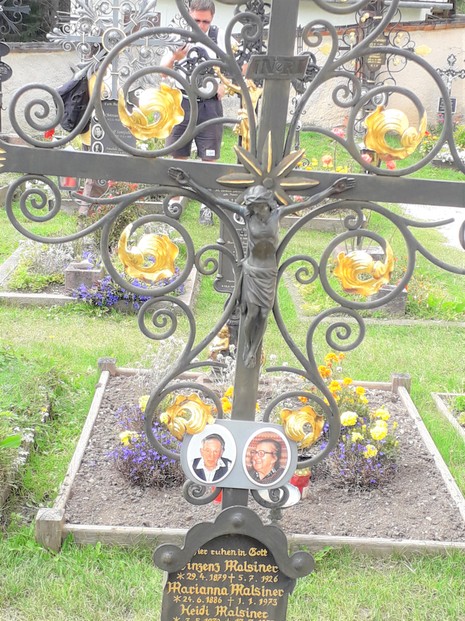 The Church Graveyard Maureen Beswick |
Higher Hikes
The next day we took a walk from which we turned back. We had intended to walk to the ridge between two valleys, but the path was closed, so we took a nearby road. That there were no other hikers on this road through the woods should have alerted us. It was steep and long and then the path turned to a stony track on whose damp surface walking would have been dangerous. "This is a potential leg breaker" I told Maureen, and so we aborted the route.
But next day we took another guided walk from one valley to another. The previous day had taught us to respect the distances in the Alps, so we took the cable car to the starting point. Besides the guide there were four of us, our companions being a friendly German couple, only the male partner speaking English. We strode across the high ridge between valleys, nearer to the tantalising, but precipitous ascents of the jagged, bare,grey Dolomites.
The paths were good and not too demanding. The trees were a natural woodland. Pica abies, known to us as the Christmas tree, was common; there were various members of the pine family; and at this level there was much larch, the only non-evergreen conifer. Rowan trees were less common than they were further down, and the same could be said of silver birch, of which we saw only one specimen.
I was delighted that I finally saw Rubus chamaemorus, the cloudberry. Even in my lifetime it has become increasingly rare in Britain, and its last redoubt is Scotland, but I saw one and sampled its berry. We picked bilberry [a close relation of the blueberry] and we came upon what is known in Britain as cowberry, an edible, but not so tasty member of the genus Vaccinium, to which blueberries and bilberries belong.
One incident amused me. The German walker and I came upon a sloe bush, and he asked me whether the fruit was edible. I said that it was then grimaced to indicate its unpalatability. His wife's face expressed disappointment, but then I told him that sloe was good in gin. Her face lit up.Faces say everything, don't they!
After tea and a cake at a hostelry we continued our walk down to the cable car and descended to Selva,where we bade farewell to our guide and our German friends. The Germans went on to a beer garden that they had discovered; we returned to our hotel and we went to the bar and ordered tea, Earl Grey for me and English breakfast tea for Maureen. Well, we are British are we not?
The views from the walk
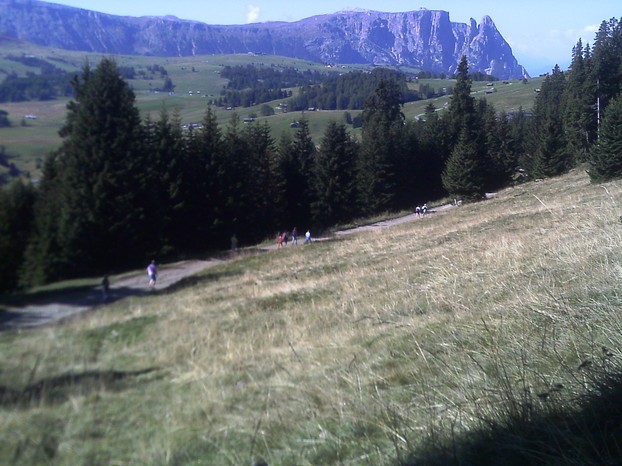 Vistas near Saltria Frank Beswick |
A Gentle Walk to Saltria
On the Monday before we left we took the cable car from Ortesei, which brought us high above the conifer woods that line the Val Gardena. We alighted and began a descent towards a beautiful valley, with lush green grass speckled with occasional trees and small farm cabins which seem to be for storage. The valley was spacious and exuded the sense that it was an area that while it was in the twenty first century it was unspoiled by it The area is popular with tourists, and various athletic young cyclists whizzed past us. We began on a road, then went onto a path.
The valley differed from the other walks which we had done, for its soil was glacial clay which in places was boggy, but wooden boardwalks had made the route walkable dry-shod.We set ourselves the destination of what we thought was a village, Saltria, but which turned out to be a ski hotel and restaurant. The path was perambulated by many walkers and presented no difficulties. On the way we were passed by a horse-drawn landau bearing tourists. We espied a pair of alpacas up on the slopes near the road, but the best animal view was a cluster of graceful horses sheltering from the fierce sun in small woodland through which the path descended. they were not wild,but tame and used to humans.
We reached Saltria, where we dined on our packed lunches of sandwiches and apple while sitting on a public bench. We eschewed the small restaurant for we wanted to eat back at the restaurant at the chairlift. This walk is not circular,unless you want to make a long walk downhill on the road to Ortesei. But we had return tickets on the cable car, so we walked back, detouring ere we took the car to the small cafe near the cable car station, with the vacation almost over. Soon we would be taking the coach to Verona airport for the plane back to Manchester with many good memories and positive experiences.
My Walking Companion and Wife
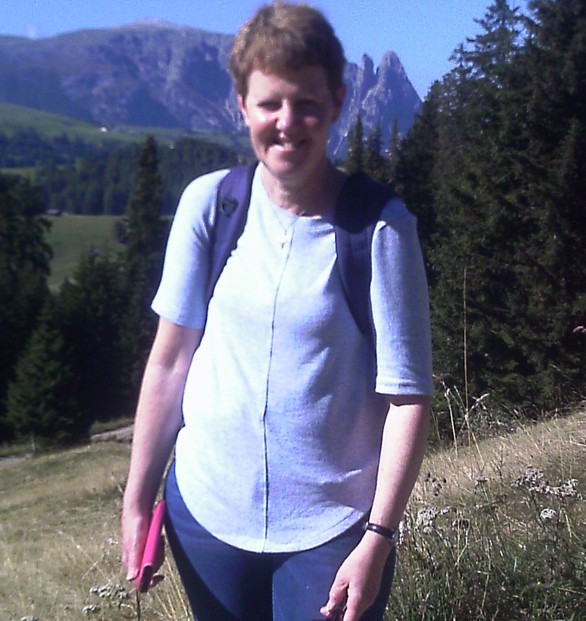 Maureen Frank Beswick |
You might also like
Affordable Italy: 6 Tips for Traveling on a BudgetVisiting Italy is a dream of many...but is it too expensive to turn into a re...
The Coming of the Cows: a Tirolean TraditionThe annual celebration of the descent of the cows from their Summer pastures ...
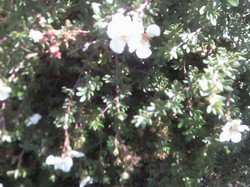

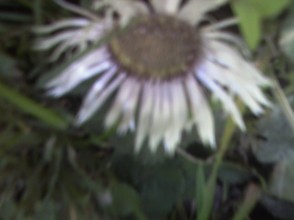
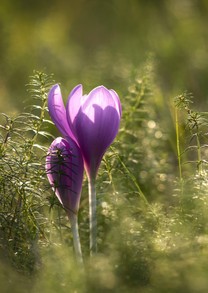




 TheThousand Year Garden28 days ago
TheThousand Year Garden28 days ago
 Women of the Gospelson 10/11/2025
Women of the Gospelson 10/11/2025
 Religious Gardenson 08/25/2025
Religious Gardenson 08/25/2025
 Doctor of the Church: John Henry Newmanon 08/03/2025
Doctor of the Church: John Henry Newmanon 08/03/2025

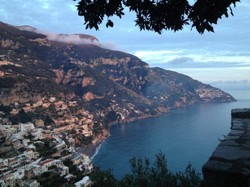
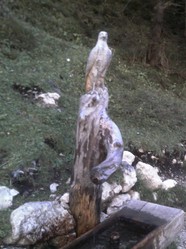
Comments
Steel is more expensive than pewter, hence was less commonly used.
Thank you for your comment below in answer to my previous observation and question.
Grave-top sculptures perhaps are intended to last beyond the lifetimes of those who inspect them so that they invoke their inhabitants' memories and spirits.
Would pewter or steel or some other metal be commoner for grave-top sculptures?
I am not sure, but pewter is less costly than steel.
Thank you for your comment below on Sep. 17, 2019, in answer to my same-day observation and question.
The metal structures atop the local graves intrigue me.
What might the metal be?
It photographs beautifully pewter-like.
Generally land in Britain lessens in fertility and becomes moorland shortly after 1000 feet above sea level.Much of the decline is due to excessive rainfall, which produces leached and acid moor soils.Southern England [excepting parts of Cornwall and Devon, which have moorlands up to 2000 feet] has chalk and limestone hills which are very fertile, but only reach over a thousand feet at one point.
The graves are of local families, who tend them carefully, so they are kept in good condition. I think that the rock is marble, as dolomite is hard to work.
frankbeswick, Thank you for the photos, practicalities and products.
You begin with the intriguing observation that "As one used to the northerly latitudes of Britain I noticed how fertile the land was at heights well above the highest point in my isle." How far down from their maximum heights do the isles transition from fertile to infertile lands?
Your wife's photo of the churchyard crosses likewise intrigues me. What is the material? The grave plaque lists dates of 1879-1926 and of 1886-1973. Yet the entire cross looks clean, clear, recent.
How lovely you've got a walking partner, who also is your wife. None of my friends like taking long walks, but I do take shorter walks myself on nature trails. I like to look for wildflowers or flowering weeds, unusual trees, and listen to the birds.
Identifying flowers from an area different from your own poses challenges to knowledge, which is often very local where flowers are concerned.For example, I saw Autumn crocus and was in two minds, for it looked like crocus, but I knew that crocus flowered in Spring. I had to have it identified for me.
It is nice to see flowers from another part of the world.
In Val Gardena the rain tends to come in the late afternoon or the evening. We got one evening' heavy rain, which we watched through the window while we were eating in the hotel dining room.
Crocus and Autumn crocus belong not only to different genera, but to different plant families, so they are not even closely related. Beware, though, while we obtain saffron from crocus, Autumn crocus, despite its lovely appearance, is very poisonous and has been known to cause death if ingested.